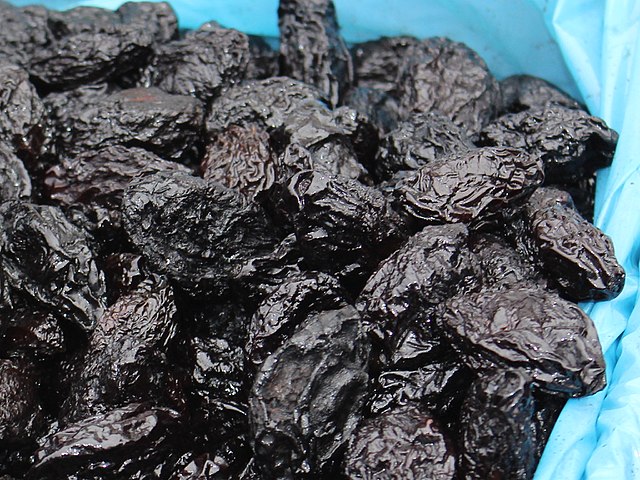
Why are prunes a laxative? They contain a lot of two different types of fiber, sorbitol, and polyphenols.
What is a prune? Prunes are dried plums, although not all plums can become prunes. Plums also have laxative properties, but they are not as effective as prunes. In America, in 2001, some prune producing companies petitioned the Food and Drug Administration to let them change the name from prune to dried plum because they said that prune is a known laxative and that gives their product a negative image.
Plums are stone fruit, which means they have a larger pit, rather than smaller seeds. Peaches, mangoes, dates, and olives are other stone fruit. With some stone fruits we eat the flesh and throw away the stone, but with some we eat the stone and throw away the flesh. An almond is the stone of the almond fruit, which is actually a member of the prune family. When the plus that are going to be used for prunes are ripe, they are harvested, and sent to a drying center for processing. They are dried in temperature controlled drying tunnels. Close to 200,000 tons of prunes are sold every year.
Prunes are known as laxatives, but what is a laxative? They are different types of medicines or products that help stools move through the intestines. The basic problem when someone becomes constipated is that the stool isn’t moving the way it is supposed to and they get blocked up. In a regular intestine, the walls of the intestines have muscles that contract and relax, slowly moving stools along them. This is called peristalsis. When someone is constipated, these muscles are not able to move the stool along. Maybe it is too big, too dry, or the muscles aren’t working properly. There are many reasons. Laxatives try to fix this problem and there are generally three different types. There are laxatives that add fiber to the stool. The fiber gets caught in the stool and makes them larger and helps them absorb more water. This makes it easier for the intestine to move them. The second type either soften the stool or make it slide more easily. They bring water and fats out of the intestine and into the stool. This makes them softer, or more slippery. The third type of laxative are stimulants that make the muscles in the intestine move more. These are quite dangerous and overuse can stop the muscles in the intestine working properly.
Prunes are effective as laxatives in two of those three ways. They provide fiber to the stool and they bring in water. Prunes have two different types of fiber. They have soluble fibers and insoluble fibers. As the names suggest, these are types of fibers that can and cannot be dissolved in water. The soluble fibers can easily absorb water from the intestines, which makes them soft and they become like a gel. The insoluble fibers don’t soak up water, but stay in one piece as they pass along the intestine. The provide bulk, which helps to push things along the intestines.
Prunes also contain sorbitol, which is a natural sugar. Sorbitol is a sugar alcohol and it is only partially dissolved in the intestine. It passes through into the large intestine and gets fermented by the bacteria there. It is often used as an artificial sweetener because it only has two-thirds of the calories of table sugar, which is another reason why fruit is so healthy. Sorbitol is hyperosmotic, which means it can draw water out of the intestines, into the stool. A big cause of constipation is dry and hard stools that are very difficult to move along. The sorbitol draws water out of the intestine, makes the stool much softer, and helps it to move freely.
Prunes also contain a lot of polyphenols. Polyphenols stop carbohydrates being digested and they have long been known for their benefits to heart health. Polyphenols are also known to be good for constipation, but nobody seems to know why. It can be shown that they do have a positive effect, but the mechanism is not understood.
Prunes are not the only fruit that have two types of fiber, sorbitol, and polyphenols. Many fruits have these, which is why doctors recommend a diet high in fruit to help with constipation. Prunes have developed this reputation because they have a very high amount of fiber, sorbitol, and polyphenols for their size. And this is what I learned today.
Image By Emőke Dénes – kindly granted by the author, CC BY-SA 4.0, https://commons.wikimedia.org/w/index.php?curid=68007888
Sources
https://www.healthline.com/nutrition/what-is-sorbitol#benefits-uses
https://www.biologyonline.com/dictionary/hyperosmotic
https://www.health.harvard.edu/staying-healthy/prune-juice-for-constipation-a-new-study-says-yes
https://www.frontiersin.org/articles/10.3389/fnut.2022.1018502/full
https://en.wikipedia.org/wiki/Prune
https://thenutmarket.com.au/blogs/health-benefits/plums-vs-prunes
https://www.thekitchn.com/stone-fruits-23402977
https://www.chelmerfoods.com/news/prune-market-overview-2022
